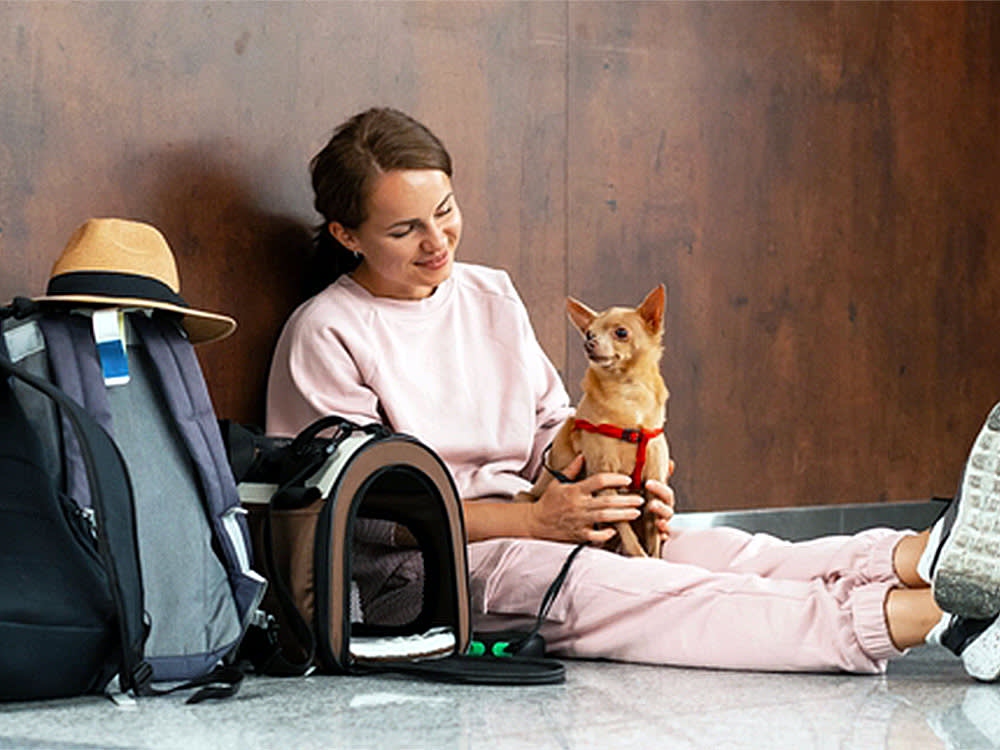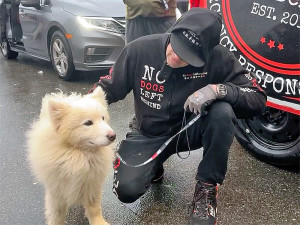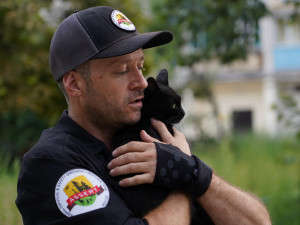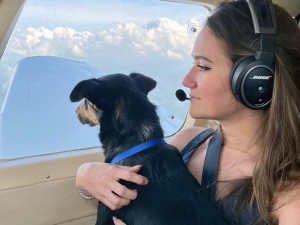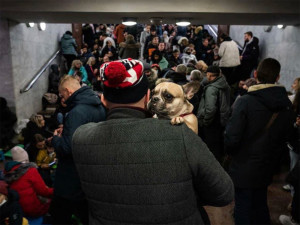The CDC Has Relaxed Their Rules for Bringing Dogs Into the US—But Not Entirely
The restrictions create financial and logistical challenges for animal welfare organizations.
Update, July 25: Since the original reporting of this story in June, the Centers for Disease Control (CDC) has updated the rulesopens in new tab that will take effect on August 1 at midnight EDT. On Monday, July 22, the CDC walked back its previous restrictions to, the organization said in a statement, “incorporate the feedback received from the public, industry partners, and various countries on the dog importation rule, and clarify and simplify the processes for those bringing dogs from dog rabies-free or low-risk countries.”
In their statement, the CDC said that “dogs that have spent the prior six months only in dog rabies-free or low-risk rabies countries will be able to enter the United States with a CDC Import Formopens in new tab online submission receipt as acceptable documentation.” The form can be filled out the same day as travel, and travelers can show the receipt to airline and border officials as a printed copy or by phone and will be good for entry into the U.S. for six months after the date it’s issued.
Trick question: All dogs are perfect! But find out which type is the best fit for you.
Even with the new guidelines, all dogs entering the U.S. must have a microchip and be over six months old, which still poses an issue for rescues bringing young dogs into the country.
Remember in 2020, when there was a rush of people adopting dogs to keep them company during a global pandemic? What you probably don’t recall is that, amid that surge, the Centers for Disease Control (CDC) made it nearly impossible to adopt a pup rescued from 113 countriesopens in new tab deemed high-risk for rabies (among them, Kenya, India, Brazil, Syria, Ukraine, and China). Their logic: The U.S. government can only handle one deadly viral outbreak at a time.
How much do you spend on your pet per year?
Three years later, we’re no longer in the throes of COVID, so the CDC has updated its rules for bringing dogs into the country. But instead of reverting to existing regulations — essentially that dogs be vaccinated before entering America — they’ve formalized restrictionsopens in new tab, which go into effect August 1. And this has many rescues on edge.
These restrictions complicate the process of bringing dogs to the US.
First, a quick recap on why such strict laws were originally put in place. Much of American rabies phobia stems from its history: Before 1960opens in new tab, dogs were considered primary spreaders, contributing to several hundred human deaths each year. But by 2007, as NPR reportedopens in new tab, rabies was all but eradicated among dogs in America, thanks primarily to canine vaccines.
Still, the CDC writesopens in new tab, “Around 4,000 animal rabies cases are reported each year, with more than 90 percent occurring in wildlife like bats, raccoons, skunks, and foxes.” (Today, rabies contributes to less than 10 human deaths each year.) However, overseas, the CDC numbersopens in new tab paint an alarming picture: Roughly 70,000 people die from the virus across the globe, with dogs contributing to 99 percent of those fatalities.
With that in mind, some new canine “import” requirements make a lot of sense. For instance, each dog being brought into the U.S. must be microchipped, at least six months of age (a good move to thwart puppy mills), appear healthy, and have a valid rabies vaccine.
But these regulations really muddle things when you’re bringing in a rescue from one of those 113 previously banned countries — where the U.S. government, out of an abundance of caution, doesn’t trust that their vaccine certificates are valid. So, even if a pup is inoculated against rabies in any of those nations, which legitimate rescues have always facilitated, the dogs must now take a blood test to verify immunity before coming Stateside (or risk being quarantined for 28 days), have a physical exam upon entering America, and get another rabies vaccine in the U.S.
This isn’t a big deal if you’re an American tourist taking your vaccinated dog along for an overseas trip. But if you work in international canine rescue, many of them mobilizing efforts to save stray or abused dogs in those 113 countries, this development is a sticking point with many cascading effects.
We spoke with two leading figures in global canine rescue — Helen Summerfield-Brown, president and founder of Stray Dog Supportopens in new tab (which works everywhere from India to Egypt to Mexico), and Jeffrey Beri, founder of No Dogs Left Behindopens in new tab (which harnesses its efforts on saving animals in the East Asian meat trade) — about how these new CDC regulations could adversely affect their nonprofit operations.
They make rescue trips a lot more expensive.
“It’s almost like extortion, forcing rescues to take their dogs into these mandatory quarantine facilities around the United States,” Beri says. Not only will there be fewer CDC-sanctioned airports to fly into, but the kennels located at these approved entry points are privately owned, albeit bonded (or certified) by the CDC.
This means, Summerfield-Brown explains, “There is no standardized pricing. We have no idea what we’re going to be charged. We’re beholden to the individual prices of these individual, private kennels.”
Both their organizations focus rescue efforts on these 113 countries deemed rabies risks by the CDC and, as nonprofits, rely on extra fundraising to make ends meet. Beri, who’s helming a much larger rescue effort that saves hundreds of dogs a year, estimates it will cost No Dogs Left Behind $350 more per pup, adding up to $500,000 more per year.
Meanwhile, the financial burden is even more profound on the leaner Stray Dog Supportopens in new tab. “I’m an independent, one-person rescue. And my expenses currently are about $80,000 a month,” Summerfield-Brown says. “I’m honestly petrified as to how much they’re going to charge. For one dog to get here, it normally costs me, say, $3,000 already.” This figure includes expenses from the point of rescue to U.S. entry.
In pre-pandemic times, she explains almost wistfully, “I would submit my import permit [with] the serology test” — which proves a dog has rabies antibodies (and was thus vaccinated) — and they would approve it along with other documentation such as microchip and vaccine records.” But now, she is apprehensive about the apparent lack of guardrails around how long a pup will have to wait upon reaching an approved airport, especially if these intake centers are flooded with rescues — which is a scenario everyone anticipates.
This outrages Beri. “If I want to bring in 55 dogs because that’s how my economics work, for example, we may not be able to bring those dogs because they don’t have space,” he says. “The facilities will force us to pay these high tariffs to have our dogs kenneled and to pay these exorbitant vet and revaccination feeds. And it’s at their beck and call when we can bring in dogs and how many dogs we can bring into them.”
These rules also create logistical challenges.
Dogs traveling internationally may only enter through a handful of airports sanctioned as ports of entry by the government, which will partner at these locations with bonded animal-care facilities. This immediately limits the scope of airports that rescues are accustomed to accessingopens in new tab when bringing dogs from the countries on the CDC’s watch list into the U.S.
Stray Dog Support is already fretting over this. Located in Wisconsin, Summerfield-Brown typically flies her dogs into nearby Chicago. However, due to the new CDC rules, that is not currently an option. “I’ve got to figure out a way to transport dogs from JFK, which is the closest airport to me now,” she says. Volunteer transports can often be unreliable and stressful, so Summerfield-Brown now has to pay for ground transport to get dogs to their adopters. “I just sent a dog from JFK down to Florida, which cost me $2,600,” she says.
Of course, there’s another twist if she needs to transport a pup even further away: “You have to pay for a domestic flight. And if you have a big dog, a lot of these domestic airlines have weight, height, and crate restrictions, so that’s another expense. So really, cutting down the airports that we can fly into is [causing me to] panic.”
Even more networked organizations, such as No Dogs Left Behind, are making concessions. “We have been focusing solely on JFK and have abandoned LAX, even though we have a lot of adopters on the West Coast,” Beri says. He says the LA airport is overcrowded and more expensive.
Fortunately, thanks to years of experience and reputation, No Dogs Left Behind has their transport processes and protocols nailed down. “We are a well-oiled machine when it comes to transporting.” This includes a long-established relationship with The ARK at JFKopens in new tab, the privately owned, CDC-sanctioned animal-reception center in the airport’s Cargo Area D. “They have been extremely helpful,” Beri says. “And we’ve had a great strategic alliance with them.”
Animals are adversely affected by these extra challenges.
“We have multiple sanctuaries in East Asia with about 350 [canine] survivors, waiting for flights,” Beri adds. He declines to disclose specifics on these sanctuary locations, citing security issues. “There are dogs in quarantine there right now, prepared for transport.”
Summerfield-Brown agrees that the animals who are suffering are the most glaring concern here. The pups, coming from countries singled out by the CDC, have already gone through a whirlwind of learning to trust their rescuers, being socialized and medically treated in quarantine spaces overseas, and then being transported thousands of miles to North America. Upon landing, “I wouldn’t even be able to see that dog,” explains Summerfield-Brown. “They get picked up and taken directly to a facility.”
Beri, meanwhile, questions how multiple vaccines in a short period may affect these dogs. “I’ve had dogs come in from China, land in Canada — had to be revaccinated in Canada. Then they came to the USA and were vaccinated again. That’s three times,” he says, factoring in the initial inoculation No Dogs Left Behind administers in one of its East Asian sanctuaries. The verdict is splitopens in new tab on the impact of successive vaccines opens in new tab on a dog’s health. This is particularly frustrating because everyone involved, from the rescue to the CDC, actually wants each dog to be healthy.
“There are actually good groups of people, like Jennifer Skiff from Animal Wellness Actionopens in new tab ... She is one working with a group of us — I’m in the coalition as well — to lobby the government,” Summerfield-Brow says. “But it is a long process.”
The CDC should work with rescues.
In the end, it’s a mystifying, if typical, case of losing the plot due to governmental red tape and lack of communication. “I’m extremely disappointed in the CDC,” Beri adds. “They should be working with people like No Dogs Left Behind, and going over processes and protocols that should be implemented because we know so much about the zoonotic diseases impacting our country, like brucellosis and leishmaniasis.”
Instead, he continues, “They’re just creating the Wild West, forcing people to black-market transport their dogs. Rescues will start moving their dogs from country to country, and then transporting dogs into the United States in dangerous ways. That is what’s going to happen.”
If you want to help support overseas dog rescue, volunteer for an animal rescue while abroad or our donate to the organizations below.
